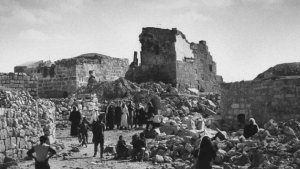
On April 18, 1996, the Qana massacre occurred as part of a major operation called the "Grapes of Wrath, " which began on the same day, April 11, and continued until April 27 when a ceasefire was declared. This operation marked the fourth of its kind by the Israeli army against Lebanon, following the invasions in 1978, 1982, and 1993, targeting 159 towns and villages in the south and west of the Bekaa Valley.
This operation aimed at three main objectives beyond those officially announced by Israeli leaders and media: reducing the erosion of the Israeli army's prestige, attempting to disarm or at least limit the influence of Hezbollah, and pressuring Lebanese and Syrian leadership to achieve these goals. It also aimed at boosting the morale of Israel's allies in the South Lebanese Army, who were living in fear and anxiety about their fate following an anticipated settlement in Lebanon.
Israeli leaders declared that the goal of this operation was to secure the northern settlements and the safety of Israeli soldiers in the occupied strip in southern Lebanon. However, observers noted statements from defense and foreign ministers, including Shimon Peres (Prime Minister of Israel at the time), indicating the three aforementioned goals. The proximity of the Israeli elections and Prime Minister Shimon Peres' desire to showcase his power played a role, attempting to face criticism from radicals within Israel after the steps he took towards modest understanding with the Arabs.
Since the Oslo Accords in 1993, both Lebanon and Israel committed not to target civilians. The Lebanese side adhered to this commitment, refraining from attacking northern Israel and focusing on clearing southern Lebanon from the forces that occupied it in the 1982 invasion, known as "Operation Secure the Galilee. "
As Hezbollah's strength and boldness grew in resisting the occupying forces in southern Lebanon, Israel became alarmed. It started violating the agreements and attacking civilians before military targets in limited operations until it lost control. Shimon Peres translated this into a military operation, attempting to regain the prestige of the Israeli army shattered by Lebanese and Palestinian resistance after the assassination of former General Rabin.
One aspect illustrating Israeli panic was the volume of ammunition used compared to the targeted area's small size. Despite the small military target area, Southern Lebanon and the western Bekaa Valley, the Israeli army conducted about 1500 aerial sorties and launched over 32,000 shells. The daily average usage of Israeli forces was 89 aerial sorties and 1882 artillery shells.
Lebanese migrants sought refuge in the United Nations forces' headquarters in the south, including the Fijian battalion in the town of Qana. Israeli forces shelled the site, which housed 800 Lebanese, along with other incidents in Nabatiyeh, Majdal Zoun, Suhmur, and Mount Lebanon, resulting in the intentional killing of innocent Lebanese civilians.
This operation led to the death of 250 Lebanese, including 110 in Qana alone, in addition to Lebanese and Syrian military personnel and several Hezbollah martyrs. The total number of casualties reached 368, including 359 civilians, and more than 60 minors were tragically killed.
After the shelling of Qana, this incident quickly turned into a major embarrassment for Israel globally. Israel hastily claimed that the site was bombed accidentally, but evidence contradicting the Israeli forces began to emerge. A video film was shot during the shelling, revealing an Israeli reconnaissance drone flying over the site during the artillery bombardment. Witnesses from the United Nations staff confirmed seeing two Israeli helicopters near the devastated site.
Israeli Prime Minister Shimon Peres commented, "It is a disgrace that there are 800 civilians living under a tin roof, and the United Nations did not inform us of that. " The response was swift and clear as UN officials announced that they had repeatedly informed Israel of the presence of nine thousand civilian refugees seeking shelter in UN locations. They also declared to the world that Israel directed its fire at international forces and UN facilities 242 times during that period, warning Israeli forces of their attack on the UN forces' site in Qana during the shelling. The UN report confirmed the responsibility of Shimon Peres's government and its army for this deliberate massacre.
Despite American and Israeli pressure on then-UN Secretary-General Boutros Boutros-Ghali to compel him to cover up the report's content, Dr. Ghali revealed certain aspects of it, which was cited as one of the reasons Washington insisted on preventing him from continuing in his international position for a second term.
In 1997, the United Nations General Assembly adopted a resolution calling on Israel to compensate the victims of the massacre, a resolution that Israel rejected.
This massacre gains special significance in light of the fact that the Israeli Labor Coalition government bears responsibility for it, despite its promotion of sincere efforts for peace with the Arabs and Shimon Peres's call for the idea of the "Middle East Market. "
One ironic twist worth noting is that despite Operation Grapes of Wrath (and the Qana massacre), Israel did not achieve any of its direct or indirect objectives. The resistance continues in southern Lebanon, and Peres was not elected as the Prime Minister.






Share your opinion